#questioneddocument
Text
Instruments Used in Questioned Documents Examination
Basic instrumentation specialised for the FDE is required for scientific investigation of questioned documents. In most cases of disputed handwriting, hand printing, and commercial printing, a stereo microscope is used. A camera coupled to a stereo microscope or a handheld digital microscope is used to uncover details exposing a simulated signature. An imaging tool, such as the VSC, is used to see the alterations. An ESDA is used to produce latent indented writing on an anonymous letter. Scanners, computers, image software, and cameras aid in the creation of court charts that show certain points of view. Insertions in typewritten texts or computer generated documents are detected using specialised grids.
---
Follow For More
---
Follow @forensicfield on Telegram for more notes and knowledge on forensic science..
Like the knowlege then Like the post...



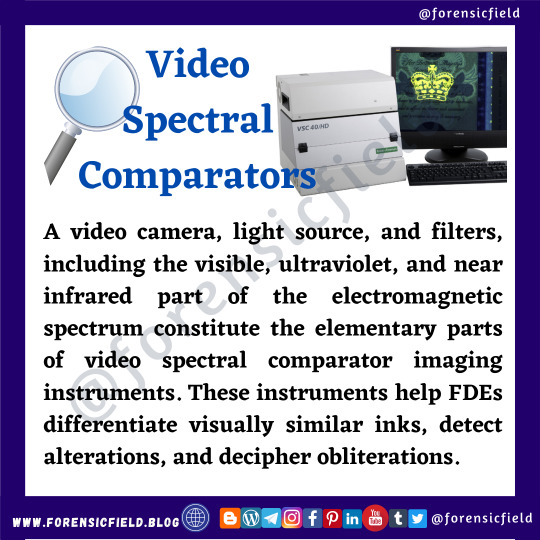
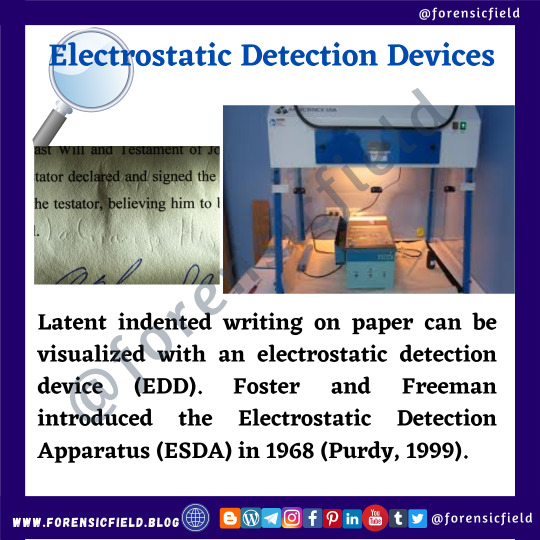

#criminology#forensics#forensic#evidence#criminalistic#forensic science#crime#forensic field#questioned document in uv light#examinations#questioneddocument
1 note
·
View note
Photo

Have you ever examined any questioned document?
Questioned Document examination is the process of checking in detail the legal document and finding out the potential authorship. Let's join and explore a new opportunity at muitonline.com
#Questioned #Document #MaharishiUniversity #MuitOnline #internationalCertification #documentexamination #questioneddocument #handwritingexpert
0 notes
Link
Sheila Lowe's handwriting analysis of 2016 Presidential candidates
http://www.sheilalowe.com/QuestionedDocuments/2016-presidential-candidates/
0 notes
Photo

The 12 characteristics of handwriting
1. LINE QUALITY
Do the lines flow or are they shaky and irregular?
This can indicate the speed of the writing.
2. WORD AND LETTER SPACING
Are the letters and words equally spaced out, or are they bunched together?
Or,
is there seemingly no pattern to the spacing?
3. SIZE CONSISTENCY
Is the ratio of height to width consistent in each letter?
4. PEN LIFTS
Does the writer lift the pen from the paper or is the writing continuous? Excessive pen lifts can hint at simulation — someone deliberately altering their natural handwriting or copying that of another.
5. CONNECTING STROKES
Are uppercase and lowercase letters connected and continuous?
6. LETTERS COMPLETE
Are the letters fully formed, or are parts missing?
7. CURSIVE AND PRINTED LETTERS
Are the letters cursive, printed, or a combination of both?
8. PEN PRESSURE
Is the pen pressure equal for upward and downward strokes?
When is the pressure applied?
9. SLANT
Do the letters slant to the left or the right, or does this vary?
10. BASELINE HABITS
Is the writing on the baseline of the paper, above the line, or below the line?
11. FLOURISHES AND EMBELLISHMENTS
Are there any fancy curls, loops or anything else unusual in the writing?
12. DIACRITIC PLACEMENT
Where are the crosses on t’s and dots on i’s? Are the t’s crossed? Is the cross on the t at the top, middle or bottom of the letter? Are the I’s dotted? If so, are they dotted to the left, the centre, or the right of the I?
Other things to be considered are spelling, phrasing and grammar.
While investigating and comparing each of the above categories, the analysers also need to consider the following:
Factors that can result in changes to a person’s handwriting:
Age
Mood
How much time they have to write
The writing instrument used
Drink and drugs
Illness
Trying to write differently
https://www.instagram.com/p/CDgF9VVl9P3/?igshid=cgz96oy3ljl6
#forensic#forensics#forensicscience#forensicfield#forensicintro#forensicinvestigation#questioneddocument#suspecteddocument#handwritingexamination#forensicdocumentexamination#criminology#crimescene#crimesceneinvestigation
14 notes
·
View notes
Photo

Question- What is Forensic Graphology?
Answer- Forensic graphology is the study of handwriting.
It is also known as graphoanalysis.
Graphology is a process that is used by some to attempt to determine personality traits and details about a person based off of their handwriting.
Forensic investigators use handwriting pattern/technology to determine personality traits of an individual.
#forensics#forensicscience#crimescene#forensic#criminology#forensicfield#forensicmcq#forensicquestionandanswer#forensicstudy#forensicinvestigation#evidence#forensicbiology#suspecteddocument#forensicknowledge#forensictoxicology#physicalevidence#questioneddocument#forensicexamination#forensicintro#forensiceducation#netjrf#forensicnetexamination#handwritinganalysis#handwriting#graphology#graphoanalysis
6 notes
·
View notes
Photo
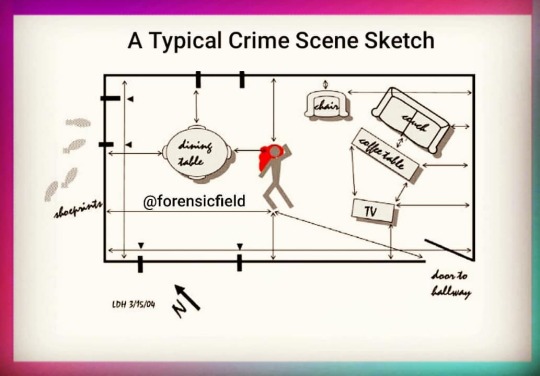
Question- What is Crime Scene Sketch?
Answer- A crime scene sketch is a permanent record of the size and distance relationship of the crime scene and the physical evidence within it. The sketch serves to clarify the special information present within the photo-graphs and video documentation, because the other methods do not allow the viewer to easily gauge distances and dimensions. A sketch is the most simplistic manner in which to present crime scene layout and measurements.
Photographer /camera positions may be noted within a sketch also.
Question- Why is a sketch important to crime scene documentation?
Answer-
■ It accurately portrays the physical facts.
■ It relates to the sequence of events at the scene.
■ It establishes the precise location and relationship of objects and evidence at the scene.
■ It helps to create a mental picture of the scene for those not present.
■ It is a permanent record of the scene.
■ It usually is admissible in court.
■ It assists in interviewing and interrogating.
■ It assists in preparing the written investigative report.
■ It assists in presenting the case in court. Well-prepared sketches and drawings help judges, juries, witnesses, and others to visualize the crime scene.
Question-When should sketches be made?
Answer- Sketch all serious crimes and accident scenes after photographs have been taken and before anything is moved.
Sketch the entire scene, the objects, and the evidence.
Question- How many types of sketches are made of crime scene?
Answer- Two types of sketches are made with regards to crime scene documentation:
1.) Rough sketches, and
2.) Final/finished sketches.
#forensics#forensicscience#crimescene#forensic#criminology#forensicfield#forensicmcq#forensicquestionandanswer#forensicstudy#forensicinvestigation#evidence#forensicbiology#suspecteddocument#forensicknowledge#forensictoxicology#physicalevidence#questioneddocument#forensicexamination#forensicintro#forensiceducation#netjrf#forensicnetexamination#crimescenesketch#crimesceneinvestigator#crimesceneinvestigation
8 notes
·
View notes
Photo

Fracture:
A fracture is a break in a bone.
Fractures can range from a hairline crack in the bone to the bone being broken into two or more pieces that no longer line up correctly. A fracture may occur at the same time as other injuries, such as sprains, strains, or dislocations.
Recovery time for a fracture can vary from weeks to months depending on a person’s age and health; the type, location and severity of the fracture.
Types of Fractures;
Fractures have a variety of names. Below is a listing of the common types that may occur:
Greenstick - Incomplete fracture. The broken bone is not completely separated.
Transverse - The break is in a straight line across the bone.
Spiral - The break spirals around the bone; common in a twisting injury.
Oblique - Diagonal break across the bone.
Compression - The bone is crushed, causing the broken bone to be wider or flatter in appearance.
Comminuted - The break is in three or more pieces and fragments are present at the fracture site.
Segmental - The same bone is fractured in two places, so there is a “floating” segment of bone.
What Causes a Fracture?
Fractures occur when there is more force applied to the bone than the bone can absorb. Bones are weakest when they are twisted. Breaks in bones can occur from falls, trauma, or as a result of a direct blow or kick to the body
Smoking and Bone Fracture:
Tobacco and nicotine increase the risk of bone fractures and interfere with the healing process, according to a growing body of research. Nicotine can slow fracture healing, estrogen effectiveness, and can counter the antioxidant properties of vitamins C and E.
____________
#forensics#forensicscience#crimescene#forensic#criminology#forensicfield#forensicmcq#forensicquestionandanswer#forensicstudy#forensicinvestigation#evidence#forensicbiology#suspecteddocument#forensicknowledge#forensictoxicology#physicalevidence#questioneddocument#forensicexamination#forensicmedicine#forensicanalysis#boneandforensic#boneanalysis#bonefracture#smoking#crimesceneinvestigation#criminalistic
9 notes
·
View notes
Photo
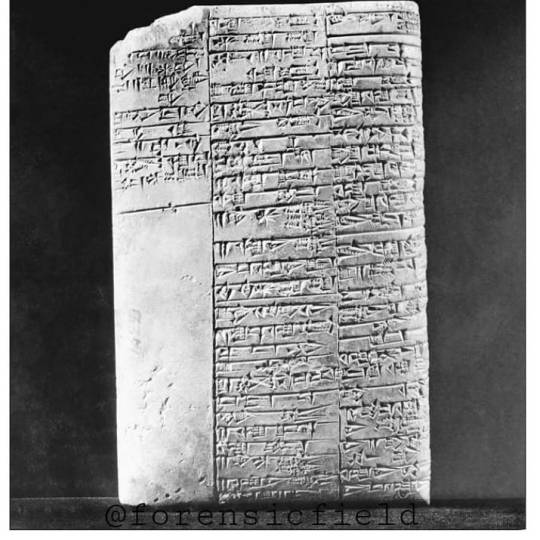
History of Drug, Poison and Chemistry
Chemistry and forensic chemistry developed largely from ancient knowledge and techniques associated with medicines. This 4,000-year-old Sumerian clay tablet in the Museum of the University of Pennsylvania has been translated by Dr. Samuel Noah Kramer of the museum and by Dr. Martin Levey of Pennsylvania State College. The tablet contains the oldest-known medical handbook. A portion reads: “White pear tree, the flower of the ‘moon’ plant, grind into a powder, dissolve in beer, let the man drink.”
(Bettmann/CORBIS/
photo dated September 27, 1953)
#forensics#forensicscience#crimescene#forensic#criminology#forensicfield#forensicmcq#forensicquestionandanswer#forensicstudy#forensicinvestigation#evidence#forensicbiology#suspecteddocument#forensicknowledge#forensictoxicology#physicalevidence#questioneddocument#forensicexamination#forensicintro#forensiceducation#netjrf#forensicnetexamination#forensicchemistry#historyofforensic
6 notes
·
View notes
Photo

Best Forensic Lines from Best Novels.
The Dark Before Dawn by Laurie Stevens is my favorite.
Which crime novel is your favourite?
Tell us in comment section 💬
#forensics#forensicscience#crimescene#forensic#criminology#forensicfield#forensicmcq#forensicquestionandanswer#forensicstudy#forensicinvestigation#evidence#forensicbiology#suspecteddocument#forensicknowledge#forensictoxicology#physicalevidence#questioneddocument#forensicexamination#forensicintro#forensiceducation#netjrf#forensicnetexamination#crimenovel#crimefiction#novel#detective#forensicquotes#forensiclines#forensicsayings
4 notes
·
View notes
Photo

Beginning of Forensic Psychiatry
The beginnings of this specialty of the forensic sciences is the M’Naughten case in England, in which an insane person shot a government official and was found guilty by virtue of insanity. One of the leaders in this field of psychiatry was Dr. I. Ray, who contributed a treatise on the medical jurisprudence on insanity. Quen had written about earlier historical aspects of forensic psychiatry in America as well. The English Court cases are summarized in this field. The development of criminal profiling is another approach in support of police investigation of cases based on a study of the behavior of the serial murderer so that a suspect can be evaluated before and after he has been placed into custody.
#forensics#forensicscience#crimescene#forensic#criminology#forensicfield#forensicmcq#forensicquestionandanswer#forensicstudy#forensicinvestigation#evidence#forensicbiology#suspecteddocument#forensicknowledge#forensictoxicology#physicalevidence#questioneddocument#forensicexamination#forensicintro#forensiceducation#netjrf#forensicnetexamination#forensicpsychiatry#forensicpsychology#psychology#insanity#mcnaughtenrule#historyofforensicscience#historyofforrensicpsychiatry
5 notes
·
View notes
Photo

Trace Evidence
Trace evidence often refers to minute samples of a substance such as hair, fibers, glass, paint chips and fragments. Crime scenes commonly contain trace evidence, often caused by the perpetrator unknowingly coming into contact with surfaces and leaving behind or picking up particulates.
Careful collection of evidences from crime scene can give lots of information about where a sample came from and how it helps to tell the story. Scientists examine the physical, optical and chemical properties of trace evidence and use a variety of tools to find and compare samples, and look for the sources or each item. Most test methods require magnification and chemical analysis.
Like it✅, Share it↩ and Subscribe it✔…..
Watch this video For more info:
https://youtu.be/8pYtQtowDpA
#forensics#forensicscience#crimescene#forensic#criminology#forensicfield#forensicmcq#forensicquestionandanswer#forensicstudy#forensicinvestigation#evidence#forensicbiology#suspecteddocument#forensicknowledge#forensictoxicology#physicalevidence#questioneddocument#forensicexamination#forensicintro#forensiceducation#netjrf#forensicnetexamination
4 notes
·
View notes
Photo

Forensic Science History
#forensics#forensicscience#crimescene#forensic#criminology#forensicfield#forensicmcq#forensicquestionandanswer#forensicstudy#forensicinvestigation#evidence#forensicbiology#suspecteddocument#forensicknowledge#forensictoxicology#physicalevidence#questioneddocument#forensicexamination#forensicintro#forensiceducation#netjrf#forensicnetexamination#historyofforensicscience#forensicsciencehistory
4 notes
·
View notes
Photo
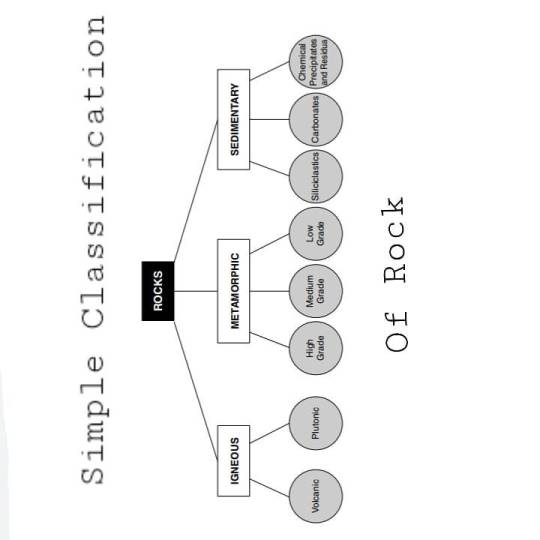
Rock and Forensic Science
👉 A rock may be defined simply as a mass of solid matter that is composed mainly of mineral crystals or grains that are texturally intergrown or held together by some form of cement.
👉 Pieces of rock have several attributes which can potentially be used as a basis for forensic comparison, including size, shape, surface texture (including weathering rinds and coatings), density, color, chemical composition, mineralogical composition, internal textural layering, fabric, magnetic characteristics, fossil assemblage (both macrofossil and microfossil), and age.
👉 Three main rock groups are:
🌑 Igneous,
🌑 Metamorphic,
🌑 and Sedimentary.
Each of which can be sub-divided, are traditionally distinguished.
#forensics#forensicscience#crimescene#forensic#criminology#forensicfield#forensicmcq#forensicquestionandanswer#forensicstudy#forensicinvestigation#evidence#forensicbiology#suspecteddocument#forensicknowledge#forensictoxicology#physicalevidence#questioneddocument#forensicexamination#forensicintro#forensiceducation#netjrf#forensicnetexamination#rock#cementadulterant#rockandforensic
3 notes
·
View notes
Photo

Classes and Types of Evidence
#forensics#forensicscience#crimescene#forensic#criminology#forensicfield#forensicmcq#forensicquestionandanswer#forensicstudy#forensicinvestigation#evidence#forensicbiology#suspecteddocument#forensicknowledge#forensictoxicology#physicalevidence#questioneddocument#forensicexamination#forensicintro#forensiceducation#netjrf#forensicnetexamination#biologicalevidence#chemicalevidence#traceevidence#evidencetype
4 notes
·
View notes
Photo
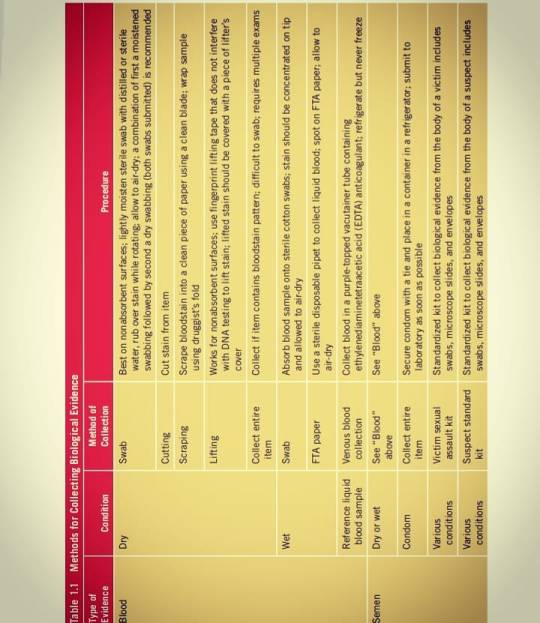
Methods For Collecting Biological Evidences
#forensics#forensicscience#crimescene#forensic#criminology#forensicfield#forensicmcq#forensicquestionandanswer#forensicstudy#forensicinvestigation#evidence#forensicbiology#suspecteddocument#forensicknowledge#forensictoxicology#physicalevidence#questioneddocument#forensicexamination#forensicintro#forensiceducation#netjrf#forensicnetexamination#biologicalsample#biologicalevidence#evidencecollection
3 notes
·
View notes
Photo

Classification of Cartridge Case:
Cartridge cases are classified into five types according to the configuration of their bases:
1. Rimmed
2. Semi-rimmed
3. Rimless
4. Rebated
5. Belted
1. A belted cartridge case has a pronounced, raised belt encircling the cartridge case body in front of the groove in the body. The diameter of the extractor flange is immaterial. The metric designation is B.
2. A rebated cartridge case has an extractor flange that is smaller than the diameter of the case. A groove around the body of the case is present in front of the flange. The metric designation is RB.
3. Rimless cartridge cases have an extractor flange whose diameter is the same as that of the cartridge case body and also have a groove around the body of the case in front of the flange. In the metric system of caliber designation, no letter is used for this type of cartridge case.
4. Semi-rimmed cartridge cases have an extractor flange that is larger in diameter than the cartridge case body, but they also have a groove around the case body just in front of the flange. The metric designation for these cartridges is SR.
5. Rimmed cartridge cases have an extractor flange that is larger than the diameter of the cartridge case body. The letter R is added after case length numbers in the metric system of caliber designation.
For more information watch the Video: https://youtu.be/Y6VUcFocLoI
#forensics#forensicscience#crimescene#forensic#criminology#forensicfield#forensicmcq#forensicquestionandanswer#forensicstudy#forensicinvestigation#evidence#forensicbiology#suspecteddocument#forensicknowledge#forensictoxicology#physicalevidence#questioneddocument#forensicexamination#forensicintro#forensiceducation#netjrf#forensicnetexamination#forensicballistics#ballistics#cartridge#cartridgecase
3 notes
·
View notes